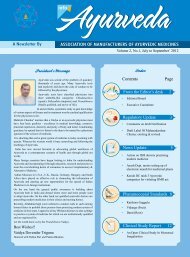Issue 12 - amam-ayurveda.org
Issue 12 - amam-ayurveda.org
Issue 12 - amam-ayurveda.org
You also want an ePaper? Increase the reach of your titles
YUMPU automatically turns print PDFs into web optimized ePapers that Google loves.
4.3. Effect of Basant Kusumakar Ras on Nerve Conduction Velocity:<br />
Nerve conduction velocity was done in 25% of enrolled cases before and<br />
after <strong>12</strong> weeks of therapy. No significant changes were noted after therapy<br />
with Basant Kusumakar Ras.<br />
4.4. Effect of Renal Function Tests:<br />
To note any adverse effects of Basant Kusumakar Ras therapy, renal<br />
function tests were carried out on all patients before, during and after<br />
therapy. There were no significant differences in these values – suggesting<br />
that, the metallic ingredients don’t exhibit any renal toxicity.<br />
5. DISCUSSION & CONCLUSION:<br />
Basant Kusumakara Ras (BKR) is described in Ayurvedic literature, to work<br />
as Rasayana. Based on its composition and other relevant descriptions, the<br />
formulation is being used by Ayurvedic fraternity, as a specific Naimittika<br />
Rasayana in diabetic population. The present observational clinical study<br />
was aimed to understand the role of Basant Kusumakar Ras in diabetes<br />
and diabetic neuropathy. Going by the therapeutic attributes of the<br />
formulation and its ingredients, it was presumed that, BKR might play<br />
some significant role in normalizing the neuropathic changes in diabetic<br />
patients. However, the results are not in full favour of this presumption as<br />
Basant Kusumakar Ras have shown some improvement in pain score and<br />
tingling score only and not in parasthaesia score, loss of sensation score<br />
and impaired pain sensation scores. Basant Kusumakar Ras was found<br />
to effective as an adjuvant therapy along with conventional therapy of<br />
Insulin and oral hypoglycemic drugs in controlling blood sugar levels in<br />
both NIDDM and IDDM patients. This observation justifies the current<br />
trends of its usage as naimittika rasayana for diabetic population. No<br />
specific safety concerns were noted for the use of Basant Kusumakar Ras<br />
in diabetic population.<br />
6. ACKNOWLEDGEMENT<br />
The investigators are thankful to Dr C.K. Katiyar from Dabur India<br />
Limited for providing the study drug samples and extending the financial<br />
help for the conduct of the study.<br />
info<br />
If you A Newsletter wish By to Publish ASSOCIATION Advertisement OF MANUFACTURERS in News OF AYURVEDIC Letter, MEDICINES get in touch with the editorial team of Info Ayurveda.<br />
The tariff for advertisement is given below:-<br />
1. Back Cover (Colour) Rs 20,000 only<br />
2. Back Cover inside (Colour) Rs 15,000 only<br />
3. Half page (Colour) Rs. 10,000 only<br />
4. Quarter page (Colour) Rs 5,000 only<br />
(Bank Draft/Cheque No._________________________________________________________________________________________________<br />
Drawn on (Bank name)__________________________________________________________________________________________________<br />
Dated _______________________ for Rs.___________________________________________________________________________________<br />
MAILING ADDRESS:<br />
Association of Manufacturers of Ayurvedic Medicines<br />
Correspondence Address :<br />
H-36, Connaught Place, New Delhi - 110001<br />
Regd. Office: 22 Site –IV, Sahibabad, Ghaziabad- 201010 (UP), Tel (0<strong>12</strong>0) 4376814, Fax : (0<strong>12</strong>0) 4376909 ,<br />
E-mail : <strong>amam</strong>india@gmail.comrakeshm@dabur.com; multani<strong>ayurveda</strong>@hotmail.com Website : www.<strong>amam</strong>-<strong>ayurveda</strong>.<strong>org</strong><br />
Note: Please enclose the CD of the Artwork alongwith Bank Draft/cheque in favour of “Association of Manufacturers of Ayurvedic Medicines”<br />
payable at New Delhi as per relevant category mentioned above.<br />
info Ayurveda, Volume 1, No.<strong>12</strong>, April-June’ 20<strong>12</strong><br />
7. REFERENCES:<br />
1. Shah, SN & Tripathi, BB [1992]; in chapter on Diabetes mellitus, API<br />
Textbook of Medicine, edited by Sainani, GS, Association of Physicians<br />
of India, Bombay, 4th ed., pp-204-205.<br />
2. Ritchie AC [ed.] [1990]: In Boyd’s Textbook of Pathology, Lee &<br />
Febiger, Indian Edition published by KM Verghese & Co, Bombay, vol.-<br />
II, pp-1780.<br />
3. Rahman, A & Zaman, K [1989]: Plants with Hypoglycaemic Activity,<br />
Jour, Ethnopharmacol., vo.26, pp-1-55.<br />
4. Mukherjee, PK, Banerjee, SN & Jain, AK [1995]: Clinical studies on<br />
Neem Capsules as an Adjuvant therapy in resistant cases of NIDDM. Data<br />
on files of Dabur Research Foundation.<br />
5. Tripathi. ID [1987]: in Trans. Of & Rasavidyotini commentary to<br />
Rasendrasarasangraha of Gopalabhatta, published by Chaukhambha<br />
Orientalia, Varanasi.<br />
6. Gupta, S K [1999]: effect of Basant Kusumakar Ras on Alloxan<br />
Induced diabetes in experimental Animals. Data on files of Dabur Research<br />
Foundation.<br />
Have you renewed our<br />
membership recently?<br />
If not, please do so immediately.<br />
Kindly contact:<br />
Mr. Tejinder Singh<br />
Email:<strong>amam</strong>india@gmail.com<br />
Tel: 0<strong>12</strong>0 3378827<br />
14




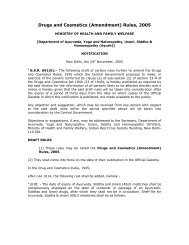
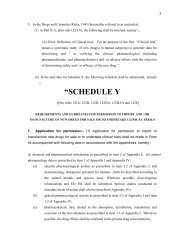
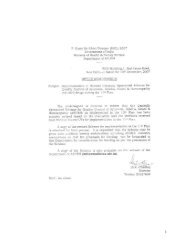

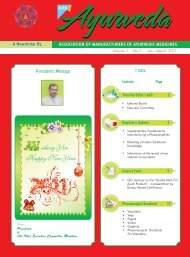

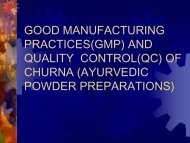
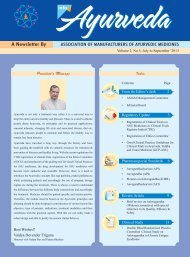
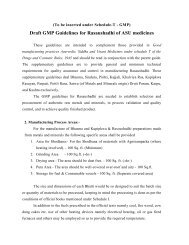
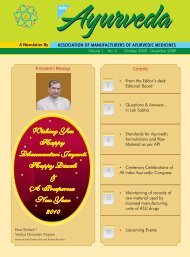
![[To be published in Gazette of India Part II Section 3, sub-section iii]](https://img.yumpu.com/28570283/1/190x245/to-be-published-in-gazette-of-india-part-ii-section-3-sub-section-iii.jpg?quality=85)

